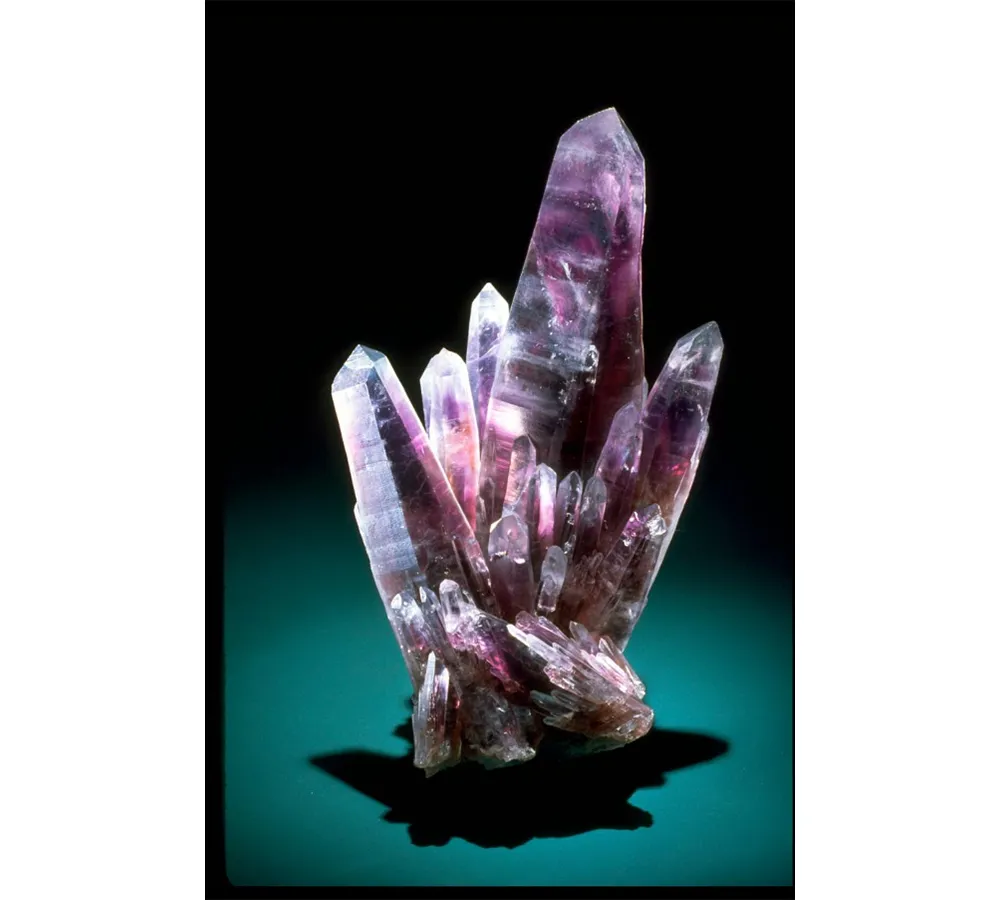
Search
All Sorts of Quartz
Quartz is one of the most abundant minerals in the Earth’s crust and is found on all continents. It exists in a variety of forms and colors, and has many uses. In this collection, you’ll explore the diversity of quartz.
Introduction

Quartz is the major component of beach sand and an important mineral in many types of rocks, including granite. Quartz is composed of the elements silicon and oxygen, and in its pure state is colorless. However, just small amounts of various impurities in quartz can yield a range of vivid colors. The profusion of colors, patterns, and textures displayed by quartz makes it one of the most widely used gem materials. Compare quartz specimens below and learn about their uses and why they look the way they do.
The early Greeks assumed quartz crystals were ice frozen so hard it wouldn’t melt. They called the crystals "krystallos," their word for ice and the origin of our word crystal. Quartz crystals really were the original "crystals."
Scroll down to see all the quartz specimens in this collection.
Many Uses of Quartz

Did you know that quartz is used every day, all around us? Apart from its use in jewelry, quartz has many applications in industry as well. Quartz sand and sandstone, both composed mainly of quartz, are some of the important materials in the building industry. The Smithsonian Castle facade, for instance, is made out of red sandstone carved from Seneca Creek, Md. Concrete, paint and adhesives are made from quartz sand as well. Do you see any object made out of glass around you? Glass too is made from quartz sand! And many other objects from our daily lives use quartz, such as watches and clocks, kitchen countertops, electronics in radios, GPS and computers, even toothpaste!
Elements and Minerals and Rocks

An element, or chemical element, is a pure substance which cannot be broken down by chemical processes into simpler substances. As of this writing, there are 118 known elements: About 80 percent of them occur naturally on Earth and the other 20 percent are called synthetic (or artificial) elements, because they are only produced in the laboratory. Helium is the most abundant element in the universe, and oxygen is the most abundant element in Earth’s crust.
A mineral is a solid formed by natural processes that has a crystalline structure — a unique arrangement of atoms — and a defined chemical composition. Minerals are the basic geological building blocks of the solid earth. They combine in different ways to make many types of rocks.
A rock is a naturally occurring aggregate of one or more minerals. The minerals in every rock help tell the story of how that rock was made. The key factors involved in the formation of many rocks are the chemical elements involved, and the temperatures and pressures they experienced when the rock is being formed. Rocks make up the Earth’s crust and most of its interior. The three main classes of rocks are igneous, sedimentary, and metamorphic.
In general, a gemstone (or gem) is a piece of mineral cut and polished by a gem cutter, or lapidary, and then used for human adornment as jewelry. There are exceptions: Some biological materials, such as amber and pearls, are also used as jewelry, as are some rocks, such as lapis lazuli. Minerals valued for their qualities of color, clarity, beauty, durability, and rarity may be suitable for fashioning into gemstones ready to be set into jewelry. Gems have facets, which are the sides or edges that have been cut, shaped, and polished. Gems may also be cut and polished into cabochons, which are rounded on top with flat bottoms.
Quartz is one of the most widely used gem materials. Gems are cut from the many varieties of quartz: amethyst, citrine, rose quartz, smoky quartz, aventurine, agate, jasper, onyx, tiger’s eyes, and others.
Crystal Shapes and Habits

Inside a mineral, atoms arrange themselves into a specific, repeating pattern called a crystal lattice or crystal structure. The smallest three-dimensional arrangement within the lattice is called a "unit cell," which is duplicated over and over again symmetrically. Minerals that are growing without outside interference tend to develop shapes that resemble their underlying crystal structures. Scientists call that kind of general, typical appearance a "crystal habit." Of course, conditions that existed during a mineral’s formation or crystal growth may change its habit, but geologists still find this attribute to be a useful tool for identifying minerals.
Scientists use more than three dozen adjectives to describe crystal habits. For example, natrolite and rutile can be acicular, or needlelike; quartz often forms hexagonal prisms; pyrite and halite typically crystallize as cubes; and mica is foliated or lamellar (layered).
Colors of Minerals

One of the most striking, yet least diagnostic, features of many minerals is their color. Well-formed minerals can be every color of the rainbow. Impurities, trace amounts of elements that do not normally belong in the mineral, may change the overall color of a crystal. For instance, depending on the trace amounts of impurities it contains, quartz may look colorless (no impurities), light pink (titanium, iron, or manganese), milky white (tiny bubbles of gas or liquid), purple (iron), yellow (iron), or brown (extra silicon). However, multiple minerals may have almost the same color, so scientists must rely on other physical properties to make definite identifications of mineral specimens.
Related Resources
Quartz
Place: Brazil, South America
Description: This is a natural white quartz crystal with phantoms. You can see part of the hexagonal (six-sided) pencil shape, which is typical of quartz.
Catalog Number: B1916700 (view complete catalog record)
Discipline: Mineral Sciences